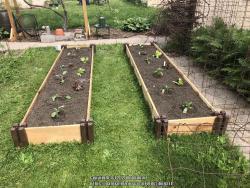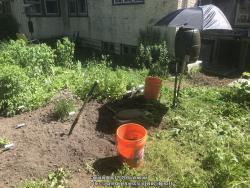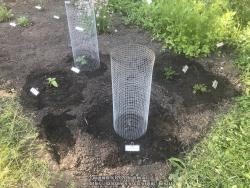Posted on Jun 10, 2020 10:10 PMGardening is a Learning Process
I wanted to stress for anyone who gardens that you don't have to be perfect. Even if you are an expert, weather can surprise you, plants just might not grow -- or get eaten by animals! -- so nothing is certain. This means that it is just fine to forget things, or be unsure, or discover that you didn't know something. It is part of the process. It matters more that you take the opportunity to learn from your experience than if you did something perfect the first time through.
I Made a Mistake
My recent goof was putting plants in the ground without first adding soil amendments.
We've generally added compost before. We compost a lot of stuff, including kitchen scraps, so we almost always have some. But I didn't even put that in the holes I made.
Now, I've been adding it on top, and I even replanted some plants that needed a more mesic soil (mine is more clay/loam). And I've been doing better in things I've planted since.
Lessons Learned
I've been lucky because I'm planting native perennials, for the most part. The climate is just fine, and they are generally pretty tolerant of soil conditions. But I'm paying more attention to those soil conditions this year, because I want my plants to have the best chance at growing. So I've been paying attention to the following:
Soil Drainage
This shows in the Plant Database; for instance, if you compare Butterfly Weed, Asclepias tuberosa with another milkweed, Swamp Milkweed, Asclepias incarnata, you'll notice the following differences:
- Butterfly Weed: Mesic, Dry Mesic, Dry
- Swamp Milkweed: Wet, Wet Mesic, Mesic
Even if you don't know what "mesic" means, you can tell that "wet" and "dry" are opposites. While you might be able to plant these next to each other, you'd have to be very careful about how you water them!
Fortunately, you can find out what these terms actually mean. I found out, thanks to
@Calif_Sue answering my post in the
Ask a Question forum, that in the Plant Database entries, you can hover over the water preference terms and get a short description of what each means. Here is what all those terms actually mean:
- Wet: poorly drained, soil usually saturated, plants may be periodically inundated
- Wet Mesic: soil often saturated, but may be dry at certain times of the year
- Mesic: average moisture
- Dry Mesic: well drained, soil remains moist for a short period after precipitation
- Dry: excessively drained
I didn't know any of this before this spring. Now I know to look for it, especially if a plant doesn't indicate it on its tag. This isn't about how often to water it, but whether or not it likes its roots dry or wet.
Soil pH
This is something I knew a little about last year. My wife had planted tomatoes in a bare area where a large spruce tree had been, with branches down to the ground. Her tomatoes did poorly; when she asked about it at a garden center, it was suggested that the soil was too acidic for them to grow. Acting on that information, we planted
Winterberry Holly, Ilex verticilata, and they have done very well, as they like acidic soil.
Most plants seems to prefer neutral pH soil (a pH of 7 or thereabouts), or are cirum-neutral, meaning they can tolerate a touch of acidity or alkalinity in their soil. But if they have a preference, the Plant Database here usually indicates what it is.
Remember that you can get a home pH testing kit if you are curious, but you can usually get a scientific soil analysis from a state university or state agricultural lab.
Clay, Silt, Sand
Dirt isn't just dirt. The soil in our gardens is made of proportions of clay, silt, and sand. Add in some organic matter, and it can make a humus that allows air and water to get through, including nutrients.
Read more in this "Soil Common Sense" article by Charlie Nardozzi, a National Gardening senior horticulturalist.
What Happened Since Last Time
I had a long weekend, so a lot has been done!
Mulching of the East Bed is Done
I spent a day finishing the mulching of the East bed. The next day, we had some rain, and I filled in the bare patches, but the whole of the East bed is mulched over cardboard or several layers of brown paper bags. We will see how that does at killing off the weeds and grass in that area, so we can plant there next year.
 Raised Garden Beds Are Filled and Planted
Raised Garden Beds Are Filled and Planted
The landscaper delivered the raised bed mix, and we spent a good chunk of the day putting in over five wheelbarrow loads into each bed. The wheelbarrow is upside-down in this first picture because a nut came off a bolt holding the axle in place, and we needed to replace and tighten it.

After that, my wife got her vegetables all planted. She has broccoli, bell peppers of different sorts, and lettuce.

We still have about a half-cubic-yard of this garden soil mix; it has manure in it. We've been adding it to established plants, so they get a little kick.
Cleaning up the Southern Exposure
I had some weeds still in the section where my Swamp Milkweed is planted. I cleared those out, and was able to put in a couple of new species: Golden Alexander,
Zizia aurea, and Prairie Smoke,
Geum triflorum. Both are Minnesota-native, and should attract more pollinators when they bloom. This picture shows them after I'd cleared some of the weeds around my Prairie Clovers (I have both white and purple).
 Herb Bed Work is On-Going
Herb Bed Work is On-Going
The Herb section of the Central bed, in the southeast corner, is not done -- I still have some oregano, which came back this year, surrounded by weeds -- but I made significant progress. Unfortunately, the day that I was able to start cleaning up this corner was a hot, sunny day. I had to throw some shade, so I lashed an umbrella to a pitchfork, which worked quite well.

I made a nice edge, then tore out the quackgrass and other weeds. I did some soil amendments appropriate for the plants I intended to put in (I learned!). We now have basil, parsley, thyme, and rosemary. There are two thyme plants; my wife picked them up because "thyme" was on my list, but I'm not sure why she grabbed two.

The hardware cloth cylinders are to protect the tender young plants. Parsley got nibbled to the ground last year, but came back; the rosemary is the tiniest plant, so I'd like it to grow a bit. I'll have to do something similar for the basil, my wife said she saw a rabbit out there the other day.
The Grapevine is Sending Out Shoots!
I noticed that I'm getting good shoots and new buds on old wood with our grapevine. I had to severely prune this back in order to have room to swap out the old grape arbor for the new one. Most of what I'm seeing are tiny pinheads of pine and light green, which barely register on my cell phone camera. But it means I'm seeing it come back as I hoped it would!
What's Next?
Next is to get the weeding done in the area of the Mercury 7 section. This covers the northern edge of the Herbs, and all the plants I originally put in the ground last year. Cleaning the edge of the planting bed is part of this, too.
The back of the Mercury 7 section is where I had Large Beardtongue plants last year, but they are the only ones that didn't come back. (I intend to plant that again in the Hummingbird section, which I will do later this summer if I have the opportunity.) When I clear the weeds from that area, I'll put in the Butterfly Weed seedlings I found when I was weeding the Herb section earlier.
I also have my East bed which needs weeding now!





